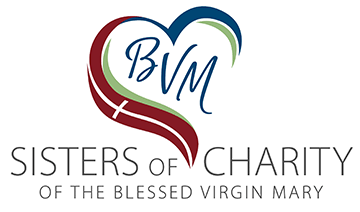From the SALT Archives: Teaching in a Technological Age
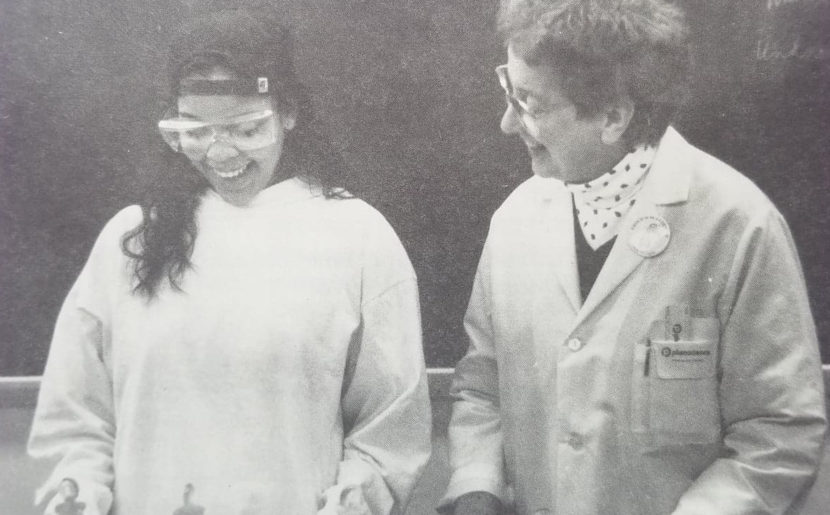
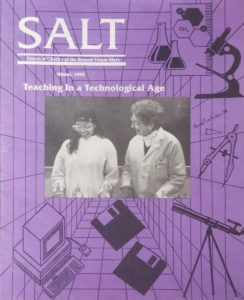
About the Article
This article was published in Salt Magazine in 1992. Captions and text have been left in their original form as they were originally published.
At the time of writing this article, Mary Ellen McDonagh, BVM was Communications coordinator for Kansas City Interfaith Peace Alliance. She died Nov. 3, 2018. Her life is honored in our online obituaries.
For BVM Educators Math (and Science) + Computers = Creative Challenge
by Mary Ellen McDonagh, BVM
Shortly after falling down the rabbit hole into Wonderland, Alice remarks, “Oh, dear, how puzzling it all is! Let me see: four times five is twelve, and four times six is thirteen and four times seven is oh, dear!”
For those who approach balancing their checkbook in dread, even with calculator in hand, or for those who don’t know their hard drive from their software, Alice’s lament may seem quite familiar. For others, however, the world of math/science/computers is both fascinating and challenging. Certainly, those who teach these subjects fall into the latter lot.
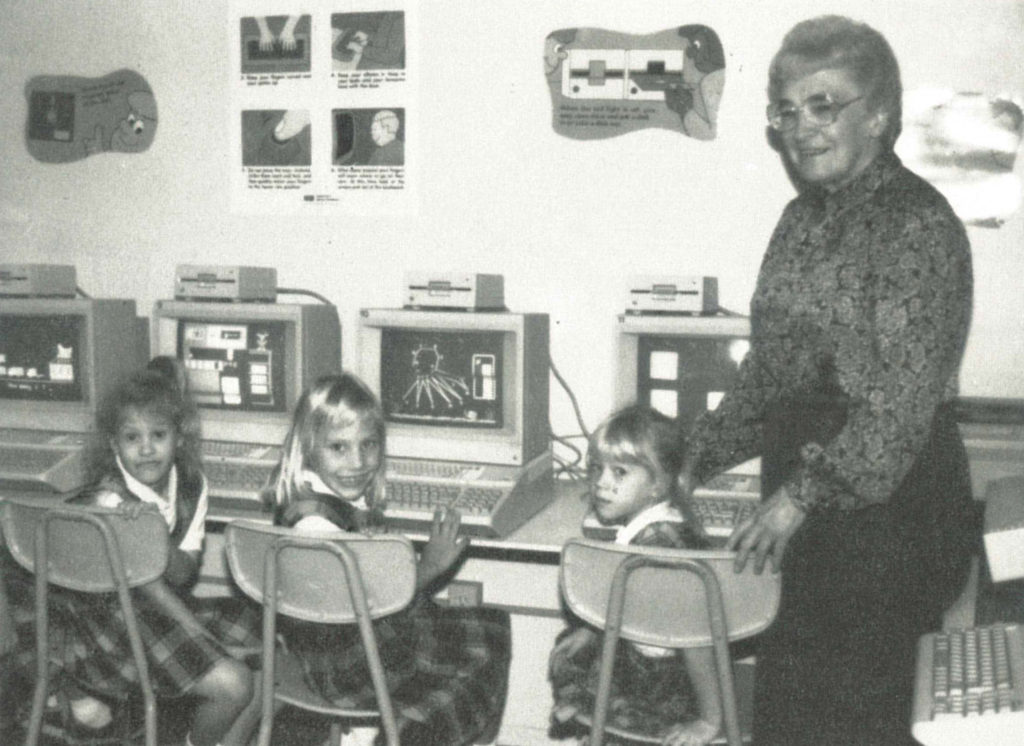
Joan Newhart, BVM, who directs several academic computing centers at Loyola University in Chicago, Ill. is one such teacher who admits, “I am one of those persons who walked into a room with a computer for the first time and wished to spend the rest of my life in that room.”
I am one of those persons who walked into a room with a computer for the first time and wished to spend the rest of my life in that room.” —Joan Newhart, BVM
She is one of many such teachers in the BVM community. Their specific ministries vary, ranging from counting animals in the jungle on a computer to working with IBM engineers. They share the common goal of wishing to impart their fascination for these disciplines to students of all levels. All work with computers.
Elementary Education
A teacher for 40 years, the last 24 of which have been spent at Holy Name Cathedral School in Chicago, Ill., Patricia O’Rourke, BVM, in addition to other subjects, teaches mathematics to students in grades 6–8. She stresses work on a blackboard as it gives “immediate information of students’ strengths and weaknesses.”
Joanne Mullee, BVM has been teaching grades 1–8 for 39 years. Eight years ago, she began using a computer in the classroom. She didn’t so much teach the computer, but rather used it as a tool to facilitate teaching. Then, three years ago, St. Francis Borgia Elementary School in Chicago, Ill. open a computer lab. Now she works with 585 students from grades K–8 each week.
She introduces a variety of simulation, tool and problem solving programs to students. In time, they use these in connection with the curriculum of their own grade level. One program, for example, is a children’s writing and desktop publishing program which combines word processing and graphics and allows students to “publish” written work in a one or two column format. This is utilized by students in grade two and above. Joanne’s students also use a computer to create cards, signs and banners for class projects and family celebrations such as birthdays.
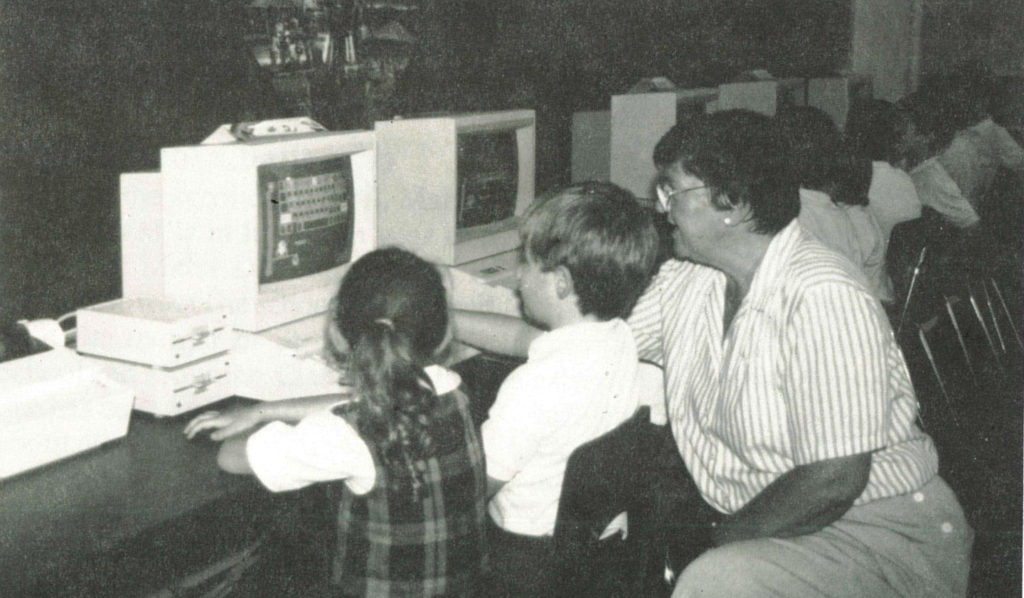
Another program she uses is the Carmen Sandiego series (as seen this year on public television). With this simulation, students use an atlas, almanac and other reference material to solve a particular crime committed in the United States, Europe, elsewhere in the world, or as Joanne says, “even better, back in time.”
An essential business computer tool adapted for students is a database—an electronic file system. Before Joanne has students create their own databases—baseball card collections, list of books read, etc.—she has them work with prepared databases. One popular one, she explains, is a simulation that takes students on an imaginary bird watching trip. The database contains some 10 characteristics for 150 different birds.
In spite of all these wonderful software options, Joanne stresses that students “do not become little robots glued to the computer monitor. Rather, they become more communicative and sensitive to others with the sharing of success and the seeking of others to help them as they need help.”
[Joanne Mulle, BVM] stresses that students “do not become little robots glued to the computer monitor. Rather, they become more communicative and sensitive to others with the sharing of success and the seeking of others to help them as they need help.”
In 56 years of teaching, Mary Catherine O’Dwyer, BVM has experienced every level of teaching from college classes for teachers of mathematics to secondary classes of math and science to her current ministry of computer training. Obviously she enjoys what she does. “When I began my present ministry at St. Robert Bellarmine School (Burbank, Calif.), I taught science to all grade levels. Many of the students were children of former students at Bellarmine-Jefferson High School.”
When the current principal, Mrs. June Rosena, came to St. Robert’s she asked Mary Catherine to develop a curriculum for computer literacy. At the time, the school had five computers of varying languages. Now there is a flourishing computer instruction program.
Mary Catherine developed a curriculum for computer-assisted reading for kindergarten through second grade. These students, she explains “experience a wealth of phonics drills.” In addition to computer training, she also teaches science to those in grades 6–8.
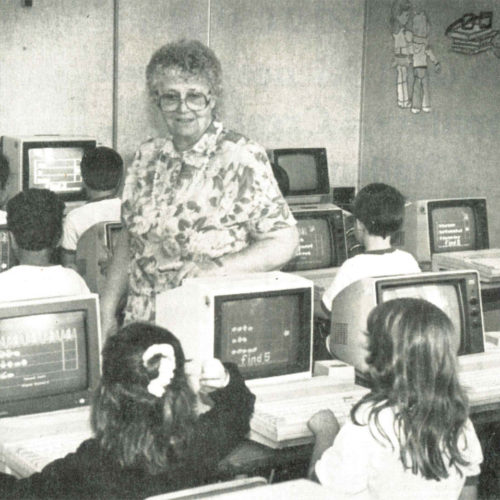
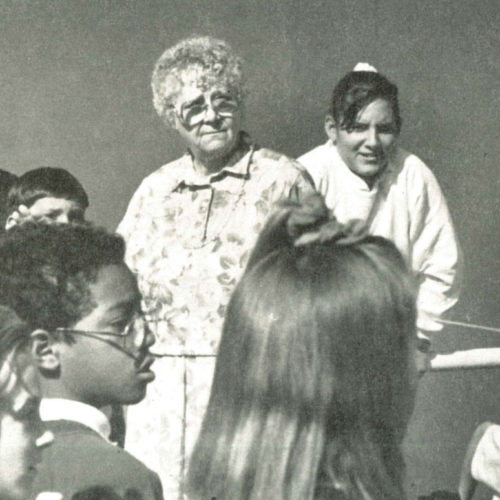
After teaching all grade levels from K–8 for many years; Marie Molloy, BVM decided “to start a new career” teaching computer skills to small groups of students at St. Francis Xavier School in Phoenix, Ariz. She also teaches typing on computers to students in grades 5–8.
Leana Kohnen, BVM is in her eighth year of computer education at St. Anne School in East Moline, Ill., teaching students in grades 1–8 “with occasional delightful episodes with kindergartners.” She feels strongly that children should sample as many different activities connected with computers as possible rather than focus almost exclusively on keyboarding, word processing or programming and she has designed a curriculum that attempts to do this.
High School Challenges
On the secondary level, Martha Ryder, BVM is in her ninth year as a teacher at Mater Dei High School in Clinton, Iowa. (The school was formed with the merger of St. Mary’s High School and Mount St. Clare Academy.) She has been teaching or studying “for about 40 years.”
I think that my thinking about ‘e’ [2.7182818284…] gives me and the school some intellectual weight we can swing around—at the students and at their parents—in our attempts to teach what the church teaches about poverty and justice.”—Martha Ryder, BVM
Lately, she has been thinking about the number ‘e’: 2.7182818284… which is included in several of the junior and senior math courses she teaches. “I think that my thinking about ‘e’ gives me and the school some intellectual weight we can swing around—at the students and at their parents—in our attempts to teach what the church teaches about poverty and justice,” she asserts. She believes that Mary Frances Clarke would be happy to have her thinking of ways to handle ‘e’ in the classroom and describes her ministry as interesting and enjoyable.
College, Math and Science
On the college level, Diana Malone, BVM and Mary Lou Caffery, BVM have been together at Clarke College in Dubuque for more than 20 years. When they came to Clarke, they joined Marguerite Neumann, BVM in the Chemistry Department and worked with her until she retired from teaching. Mentoring, relates Mary Lou, “is one of the ‘in’ words today for attracting women to science and certainly Marguerite was our mentor. She set the standard for quality which we try to carry out in our ministry today.”
Both Diana and Mary Lou have PhDs in chemistry and Mary Lou has a master’s in computer science. Both consider computers integral to the chemistry curriculum and use them extensively “because the computer is such an important tool for scientists.” That integration, explains Mary Lou, includes computer assisted instruction, but more importantly, computerized data acquisition and analysis and information retrieval from large national databases.
Diana is currently on sabbatical from Clarke, working with IBM Educational Products Division in Boulder, Co. She is working with IBM engineers in developing the hardware and software for experimentation in chemistry using an interface device to the IBM computer. She previously worked on similar materials for the Apple computer and has published two lab manuals related to that project. She also serves on the Computer in Education Committee for the American Chemical Society.
Mary Lou has been involved in research on molecular modeling with Professor Theodore Brown at the University of Illinois. That, too, involves a computer application. At Clarke, she emphasizes mathematical tools using the computer to model chemical system behavior. In addition, she describes herself as the department “specialist” on using DIALOG Information Systems and STN International, both national databases. Clarke offers a seminar on scientific information retrieval at the sophomore/junior level for chemistry majors.
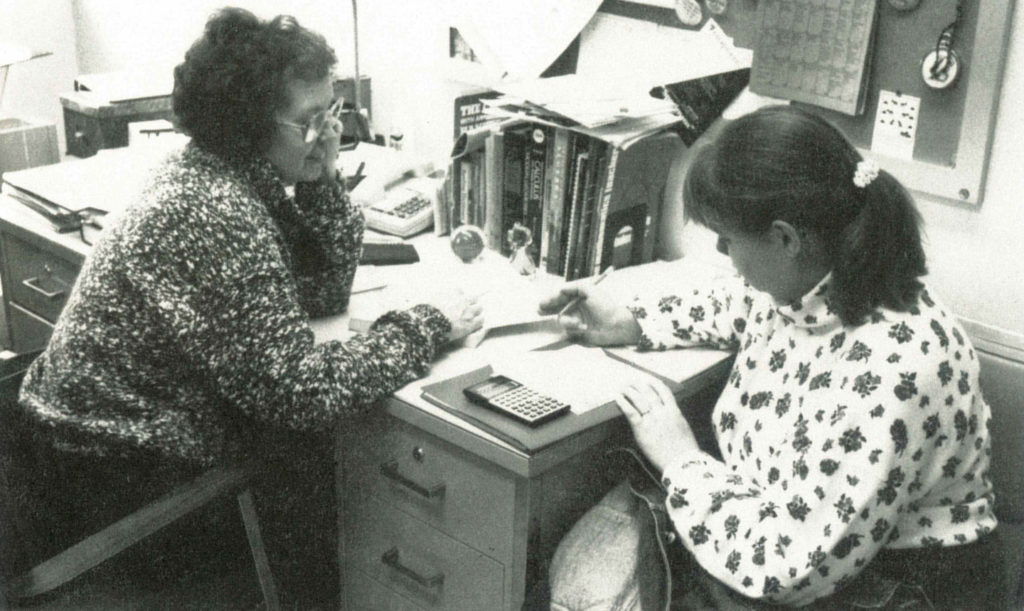
Since 1974, Carol Spiegel, BVM has been a faculty member in the Mathematics Department at Clarke. She teaches basic algebra courses through discrete (not discreet) math, calculus, geometry, linear algebra, and math seminar.
Prior to coming to Clarke, Carol taught mathematics on the secondary level at Carmel High School in Mundelein, Ill. and Xavier High School in St. Louis, Mo.
Teaching at California State University in Northridge (CSUN), in the San Fernando Valley, California is Rita Basta, BVM. Primarily she teaches Mathematics for Elementary School Teachers. In her courses, Rita says that she tries to use manipulatives such as Cuisinere rods, pattern blocks, geoboards and tangrams as well as collaborative learning styles (working in groups) so as to acquaint future teachers with the tools young people experience in elementary schools.
Classes are often taught, [Rita Basta, BVM] explains, using a Liquid Crystal Display (LCD). This is a device put on an overhead projector which when connected to a computer can project the computer monitor onto a screen.
Her students use computers and learn to write programs in Basic and Logo languages. Classes are often taught, she explains, using a Liquid Crystal Display (LCD). This is a device put on an overhead projector which when connected to a computer can project the computer monitor onto a screen.
Rita regularly attends meetings on assessment techniques, classroom research, writing across the disciplines (WRAD) and multicultural awareness. Last semester she researched “how to overcome math anxiety in doing word problems” and next semester she plans to research “learning how to enjoy reading a math book.”
Influenced by WRAD workshops, Rita gives writing assignments in all her math classes because she feens, “A student should be able to write clearly, regardless of subject matter.” She also tries to create opportunities for multicultural awareness (a large portion of students are Asian and Hispanic) as, she says, learning/teaching techniques vary by cultural background.
Students know she is a Catholic Sister teaching in a public university. Frequently, Rita says, “students come to talk, ask for advice, etc. They know I am available and that I will bring their concerns to prayer.” Also in Southern California is Pat Peach, BVM who just this year began teaching math at Pasadena City College. Much of her time is spent with students in the math lab, where they acquire the skills to be successful in college math courses, and where Pat frequently does informal counseling as well.
Pat’s students include a woman whose husband is terminally ill, and who is rushing to prepare herself for a career that will enable her to support her four children. Another man, from El Salvador, is disabled and his only surviving sister was recently injured critically in a car accident.
These students, Pat feels, “have enough motivation to survive the discipline that math demands, but for others the distance between my class and their career dreams seem so great that they abandon both. Those students need my encouragement and support as much as my expertise in making math understandable.”
Harriet Holies, BVM is currently teaching math at Loras College in Dubuque, Iowa. Her students include traditional-age college students “with an occasional non-traditional age adult.” Many, but not all, of her courses are low-level algebra courses required for the liberal arts component at Loras. “A large percentage of students,” Harriet observes, “struggle because they have a great deal of anxiety or because they are poorly prepared or because they have had negative math experiences or all three.” Some students are in the learning disability program.
She has taught college mathematics for 30 years, but during the last seven, she has “put a great deal of time, energy, skill and prayer into discovering ways of teaching mathematics that will allow students to succeed in mathematics, perhaps for the first time, after studying for 13 or 14 years.” From the start of a course, she tries to create a hospitable environment in the classroom that will encourage students to ask necessary questions and to overcome anxiety. Students are encouraged “to speak and to write mathematics in addition to hearing and seeing it.”
“Many students come to my office individually or in pairs,” she reflects. “This way I discover wrong mathematical models that they have carried in their heads for years which are not easy to discover in a classroom setting.”
Living the BVM Mission
Harriet, like other math/science/computer teachers in the BVM community, believes her ministry is consistent with the vision and spirit of Mary Frances Clarke with the BVM mission of being free and helping others to enjoy freedom.
For years now, I have looked upon this kind of mathematics teaching as a ministry.”—Harriet Holies, BVM
“For years now,” she continues, “I have looked upon this kind of mathematics teaching as a ministry. So many students have been wounded in the process of trying to learn mathematics, I see what I do as a help to bring some healing to this woundedness.
“Just this week a senior who has struggled painfully and valiantly with math received a perfect score on a quiz, I think for the first time in her life. She was elated and so was I. And, she was a bit more whole.”
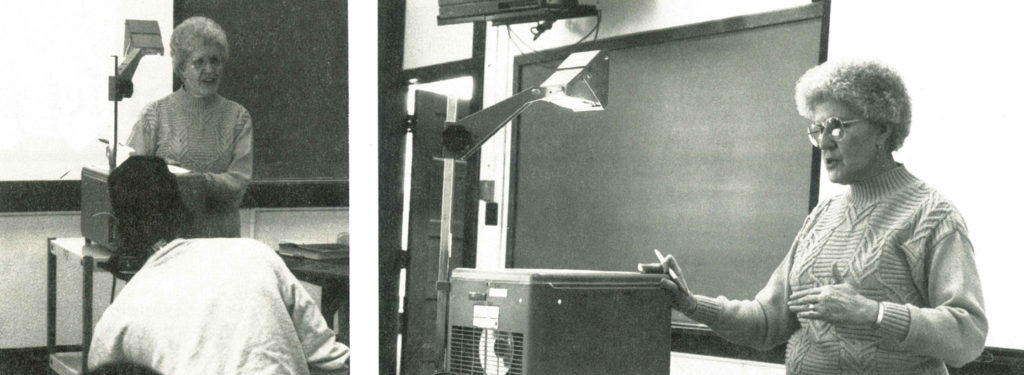
It is mainly in education and particularly apparent with continuing education students that Carol Spiegel, like Harriet, finds herself being freed and helping others to be free as well.
“When I witness the additional self-confidence and release from anxiety of a student who has finally mastered some basic mathematical techniques, I really have a sense of mission,” she reflects. Similarly, Mary Lou Caffery firmly believes that education is the source of freedom and notes that the “liberal” or “liberating” arts are at the heart of Clarke.
For Marie Molloy her ministry is consistent with that of Mary Frances Clarke in that she “allows students to feel free to go ahead in a creative spirit, at their own risk and to move into the future with new insights.”
Pat Peach recalls that Mary Frances Clarke’s concern for the plight of the foreign born Irish and their children prompted her commitment to education. “The same spirit of compassion engages me in teaching today’s immigrants and their children, assisting in their search for freedom and equality.”
Because students will be moving into a technological society as adults, they need to be “at home” with such technology, [Pat Peach, BVM] insists. “This ‘at homeness’ is truly a freeing experience for many students.”
Joanne Mullee believes that she, like Mary Frances Clarke, is responding to the needs of her time. Because students will be moving into a technological society as adults, they need to be “at home” with such technology, she insists. “This ‘at homeness’ is truly a freeing experience for many students.”
Joan Newhart also believes that her ministry is making technology available to students, some of whom, she notes, are women continuing their college education after a long time lapse. Technologic, she admits, often gets the “bad rap” of producing “nerds whose social skills are next to nothing.
“I’ve met a few of those, but l also know a number of technical people who are gifted with enviable social skills,” she observes.
Mary Lou Caffery concurs. “The mistaken association of science and math with only left brain activity and creativity only with right brain activity has always bothered me. I think truly intelligent and creative people are ‘whole-brained.’”
Certainly the creativity of BVM math/science/computer teachers attests to Mary Lou’s concept of being “whole-brained.” Joan Newhart has adapted a public domain program on the Wheel of Fortune by incorporating the vocabulary of a particular discipline. Frustrated with available science books, Mary Catherine O’Dwyer created her own texts with a “hands-on” emphasis for grades 6–8.
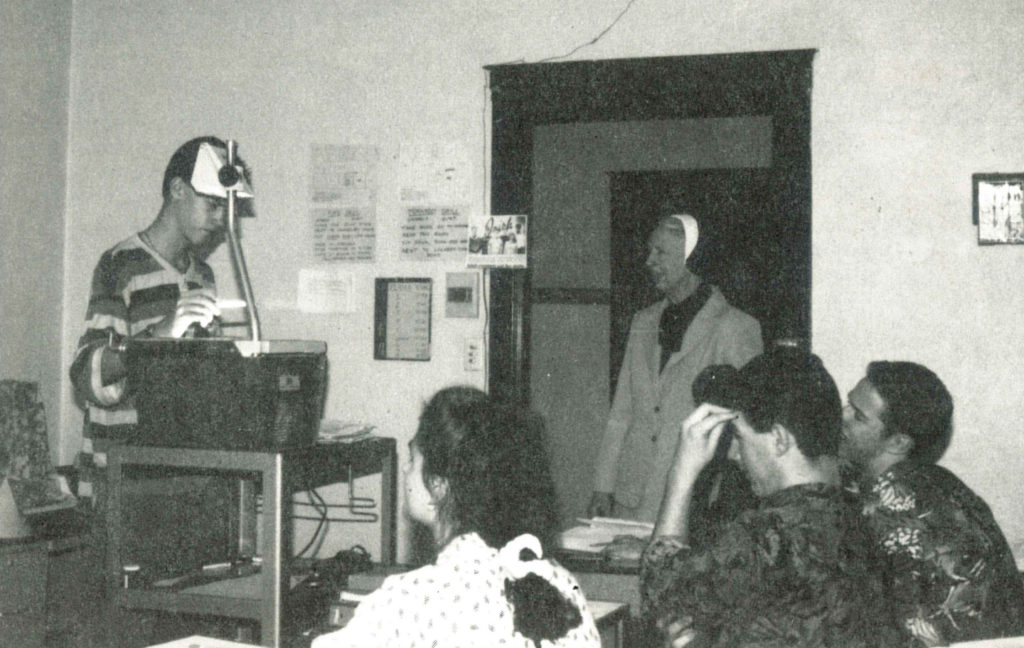
While some math/science/computer teachers admit that they have not succeeded in integrating ministry with prayer, others have not seen this integration as a problem. Martha Ryder says, “Students enjoy it when I tell them that I thought of a new way to explain something during Mass.”
“Prayer for and about my students takes my teaching into my prayer,” reflects Carol Spiegel. “Prayer often comes into my ministry through quick and sometimes fervent petitions that I correctly answer a difficult question or find an explanation that makes sense for that puzzled student. I also believe that the act of carefully doing my ministry is a form of love and prayer.”
Like Carol, Harriet also finds her students entering her prayer. Each morning, her prayer includes the prayer of Catherine of Sienna which begins, “I pray for all those you have given me, who I love with a special love and who you have made one thing with me.”
“As I pray this,” Harriet reflects, “often the faces and the pain of various students come·to me. I hold them in my heart then, as I will meet them in the classroom later. Sometimes I need to face my own weakness in relating to a student. That, too, becomes part of the prayer.”
Patricia O’Rourke finds that prayer motivates her “to continue in the difficult task of teaching.” Eighth graders in Earth Science class of Mary Catherine O’Dwyer begin each class with a Native American prayer begging the Earth to teach them gentleness and prayerfulness. Life Science class students use the prayer thanking God for their bodies and the wonderful works of creation.
There may still be those who share Alice’s lament, but they will find it difficult to ignore an increasingly technological society.
There has been such an improvement in the software available for children, since I began this work, and recent advances in technology … are breathtaking.”—Leana Kohnen, BVM
“There has been such an improvement in the software available for children, since I began this work,” concludes Leana Kohnen, “and recent advances in technology … are breathtaking.
“I fervently hope that ways can be found to finance such materials and that these improvements will generate in older students a real interest and joy in learning and in research, somewhat akin to the delight I see in the eyes of little ones when the monkey on the screen dances because they have successfully counted the animals in the jungle.”
Featured image: Mary Lou Caffery, BVM enjoys teaching as much as Clarke student Angela Jones enjoys learning.
